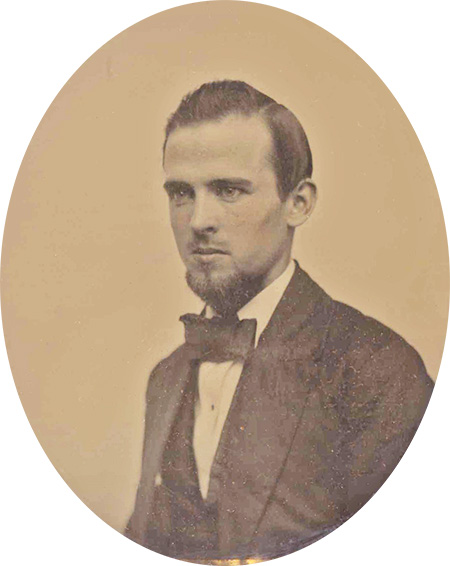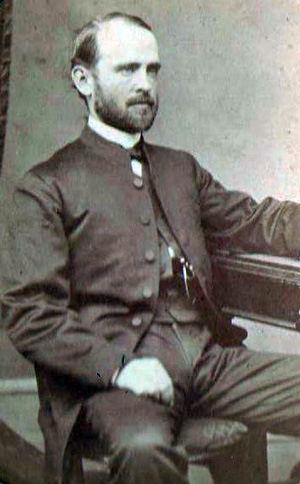We recently received 2 photos of our Civil War rector the Rev. Alfred Randolph from John Hennessey, chief historian of the National Park Service in Fredericksburg. These pictures represent our earliest photographs of St. George’s rectors.

Although both are undated, one is clearly earlier than the other which is shown to the left. He came to St. George’s in 1858 and married his wife Sarah “Sallie” Hoxton on April 27, 1859 and moved to the rectory at 303 Hanover St. which still stands. Randolph had the difficult task of following possibly the most popular rector in our history, Edward McGuire.
Two months later he invited his Virginia Theological Seminary friend Phillips Brooks to preach his first sermon at St. George’s. Brooks became the most eminent Episcopal priest in the late 19th century as well as the writer of the words to “O Little Town of Bethlehem.” Randolph provided an account of his visit and writes he was “the best young preacher they [congregation] have ever heard.”
By 1861 the country embroiled in the Civil War. Locally another problem surfaced – scarlet fever. Trip Wiggins notes all the burials Randolph did.
John Hennessey comments on the dire situation. “That winter of 1861 into early 1862, what with the death of soldiers and all the children from the Scarlett Fever epidemic—what a time that was for Fredericksburg.” Separately he wrote, “Given that, and given the 41 names that are almost certainly associated with the epidemic, Jane Beale’s estimate of “at least one hundred” seems entirely possible. If so, by a wide margin, that would make the 1861 scarlet fever epidemic the most deadly disaster to befall the residents of Fredericksburg in the town’s history.”
Randolph became one of at least 4 St. George’s rectors to publish a book in their lifetimes. Others include Edward Randolph, John Lanier and Thomas Faulkner. His address “Address on the Day of Fasting and Prayer Appointed by the President of the Confederate States, June 13, 1861” was delivered at St. George’s and printed in Fredericksburg. Randolph later published a series of lectures presented at General Theological Seminary in NY in 1901 and 1902.
Randolph was forced to evacuate Fredericksburg in Nov., 1862 at the onset of the battle with his wife on day old infant. He never returned to preach.
This week we remembered Veterans’ Day 2016. In that capacity, Randolph served as a chaplain from 1862-1864. According to the Bishop of NC Joseph Cheshire writing in 1912, Virginia sent more chaplains to war than any other state – 29 of 115 clergy. He writes about Randolph, “The Rev. Alfred M. Randolph, since Bishop of Southern Virginia, was driven out of his house, with his wife and their infant a day old, by the bombardment of Fredericksburg; and being thus without a parish became a chaplain in the army, displaying the most devoted, single-minded courage and zeal on the battlefield among the wounded, under the fire of the enemy, and in the sorer trials of ministering in the crowded field and post hospitals.”
We have a short sketch of Randolph in the “Top 300 St. Georgians collection”
The second photo is a more mature picture and is notated below the picture as “Bishop Alfred Magill Randolph”. His beard is more developed and he has less hair:

